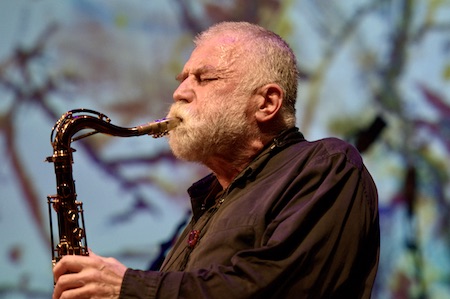Oct 28, 2025 10:47 AM
In Memoriam: Jack DeJohnette, 1942–2025
Jack DeJohnette, a bold and resourceful drummer and NEA Jazz Master who forged a unique vocabulary on the kit over his…

Brötzmann worked with nearly every major name in free-jazz within Europe.
(Photo: RI Sutherland-Cohen)Peter Brötzmann, a German saxophonist and clarinetist whose music charted a provocative, uncompromising new course for free-jazz, died June 20 at his home in Wuppertal, Germany. He was 82.
His death was confirmed by The Guardian, who spoke to Brötzmann’s label, Trost Records, and his collaborator Heather Leigh, the Scottish pedal steel guitarist. Leigh said that Brötzmann had passed away in his sleep.
Atonal and stylistically abrasive, Brötzmann often seemed to be aiming for a pure, unfettered catharsis on his horns, which included tenor and alto saxophones, clarinet and the Hungarian tárogató. He eschewed conventional melodic and rhythmic structure, and even shed nearly all audible vestiges of blues and African American roots in his playing. That said, he was also a frequent collaborator with African American musicians such as Cecil Taylor, Sonny Sharrock, Andrew Cyrille and Ronald Shannon Jackson.
Brötzmann was a prolific recording artist, making nearly 120 albums as a leader or co-leader and dozens more as a sideman. His second recording, 1968’s Machine Gun, is regarded as a landmark in the European avant-garde jazz scene. Over the years his sound broadened to include more lyricism (especially when playing clarinet), although he never put aside the coarse, volatile sound that had first distinguished him. Nor did he cease experimenting: One album, 1977’s Schwarzwaldfahrt, notoriously found him playing his tenor saxophone while it was submerged in a river.
While his bountiful recordings vividly illustrated his evolution as an artist, Brötzmann himself was uninterested in reflecting on it. “That’s not my cup of tea,” he told an interviewer in 2019. “You compare if you want, I don’t look backwards, there is still now and tomorrow.”
Former U.S. president Bill Clinton counted himself a fan, in 2001 calling Brötzmann “one of the greatest alive.”
Brötzmann was born March 6, 1941, in Remscheid, Germany. In his youth, he aspired to be a painter (with saxophone, on which he was entirely self-taught, as a hobby), and he formed an association with Nam June Paik and other members of the experimental Fluxus movement, though he was never a full-fledged member. Paik, in particular, encouraged him to concentrate on his music, which was already showing great originality (though it was also already alienating). “I realized that I liked being on the road together with other musicians and built up something new and unheard,” he later recalled.
Brötzmann formed a trio with bassist Peter Kowald and drummer Sven-Åke Johansson, toured Europe with the Globe Unity Orchestra and Carla Bley and Michael Mantler, and recorded his first album, 1967’s For Adolphe Sax, which he self-released, since no record label would touch it.
It was his follow-up, the octet recording Machine Gun, that hit like a tidal wave: a “declaration of European independence,” as writer Ekkehard Jost put it. Its sustained intensity was a massive influence for free-jazz musicians across the continent. Many of its participants — including drummer Han Bennink, pianist Fred van Hove, guitarist Derek Bailey and saxophonist Evan Parker — became free-jazz major figures in their own right as well as longtime collaborators with Brötzmann. In particular, he formed a trio with Bennink and van Hove that worked together for much of the 1970s.
Over the years, Brötzmann gradually worked with nearly every major name in free-jazz within Europe. He also engaged with a wide swath of players based elsewhere, including South African drummer Louis Moholo-Moholo, Japanese percussionist Sabu Toyozumi and Americans John Zorn, Bill Laswell and Ken Vandermark in addition to Cyrille, Sharrock, Jackson and Taylor. He was a member of the supergroup Last Exit in the 1980s, and leader of the Die Like a Dog Quartet in the 1990s and 2000s. Most recently, he had collaborated regularly with Leigh; their last album, 2023’s Naked Nudes (also featuring cellist Fred Lonbeg-Holm), was their sixth together.
Brötzmann had long been dealing with health issues, which came to a head early in 2023 when he was traveling back to Germany from residencies in Warsaw and London. “I had a complete breakdown,” he acknowledged in a statement on Trost Records’ website. “Emergency, re-animation, intensive care … I have no idea what the future will look like and no, I won’t be able to play in the (near) future, means no travel and no stage. No good news, my friends. But it is how it is, and yes, I will do my best to stay with you. … Best to you all.” DB

Jack DeJohnette boasted a musical resume that was as long as it was fearsome.
Oct 28, 2025 10:47 AM
Jack DeJohnette, a bold and resourceful drummer and NEA Jazz Master who forged a unique vocabulary on the kit over his…

Goodwin was one of the most acclaimed, successful and influential jazz musicians of his generation.
Dec 9, 2025 12:28 PM
Gordon Goodwin, an award-winning saxophonist, pianist, bandleader, composer and arranger, died Dec. 8 in Los Angeles.…

Flea has returned to his first instrument — the trumpet — and assembled a dream band of jazz musicians to record a new album.
Dec 2, 2025 2:01 AM
After a nearly five-decade career as one of his generation’s defining rock bassists, Flea has returned to his first…

Nov 13, 2025 10:00 AM
For results of DownBeat’s 90th Annual Readers Poll, complete with feature articles from our December 2025 issue,…

To see the complete list of nominations for the 2026 Grammy Awards, go to grammy.com.
Nov 11, 2025 12:35 PM
The nominations for the 2026 Grammy Awards are in, with plenty to smile about for the worlds of jazz, blues and beyond.…








